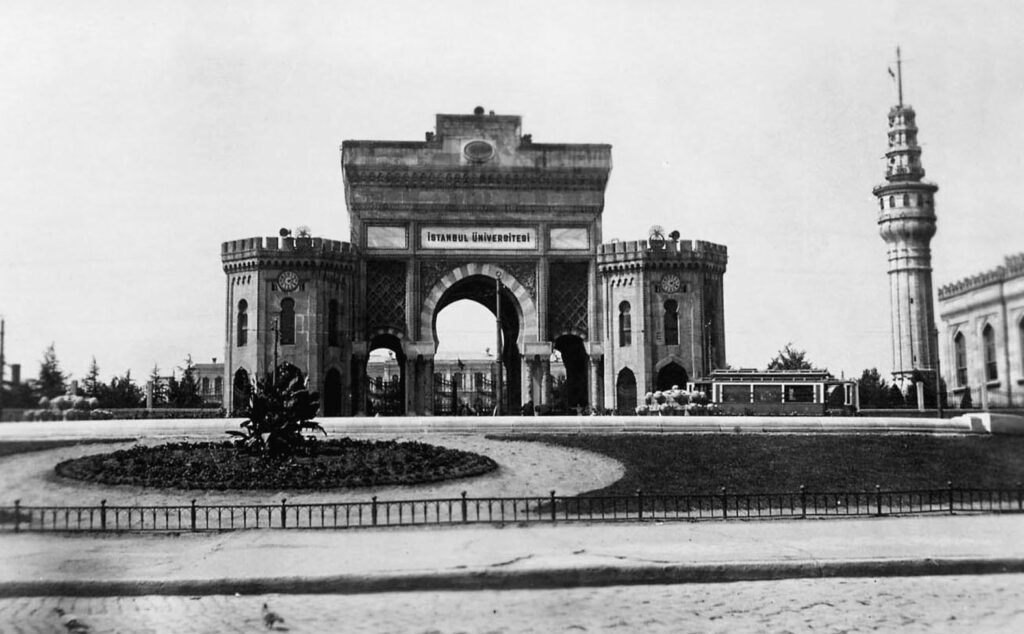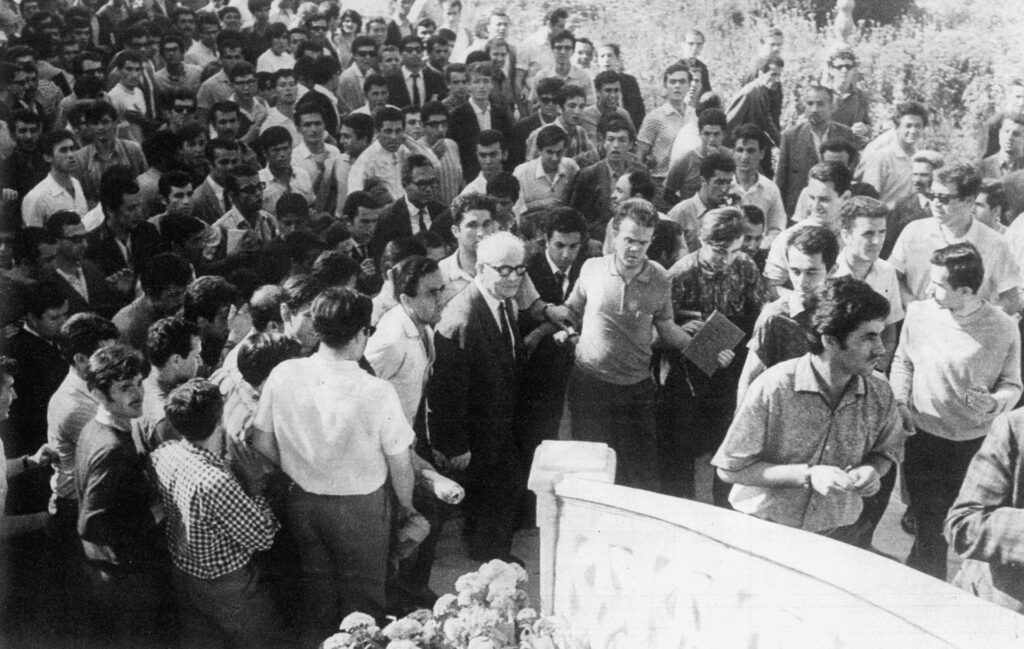Although the foundation of Istanbul University is claimed to date back to 1453 based on the common thought that it was an extension of “Sahn-ı Seman Madrasa” built on Fatih Sultan Mehmed’s order in 1453, the university was actually built in 1933 as the first and only university of the Turkish Republic. Starting as an Ottoman academy in the 19th century, Darülfünun had been reestablished under different names in 1863, 1869, 1874, and 1900, finally was closed in 1933 due to the University Reform, giving place to Istanbul University.

Feza Kürkçüoğlu Archive
The main building of Istanbul University was built by the architect Bourgeois between 1864 and 1866. Significant for its baroque architectural style, the building started to be used as the Ministry of War in 1879. Following the Istanbul earthquake in 1894, the building was repaired by architect Raimondo d’Aranco, then renovated by architect Ekrem Hakkı Ayverdi, and today houses the Rectorate building, Dean’s offices of Economics and Law faculties, and administrative offices.

Feza Kürkçüoğlu Archive
Istanbul University has an important place in the history of the revolutionary student movement. Although the student movement emerging in the 1940s faced great resistance, students could organize through the unions and federations they had established. Clashes and boycotts had continued in the faculties until the 1980 Coup, a pivotal moment and milestone. Yet, the 1980s had been the period for the students to reorganize and establish unions.
Before the 1960 Coup, on April 28th, 1960, a forestry student, Turan Emeksiz, was killed by the police, and his body was secretly buried the next morning during the demonstrations against Democrat Party’s oppressive regime. However, despite all efforts, they could not stop Emeksiz from being commemorated as the “Liberty Martyr”.
The revolutionary students of Istanbul University started a boycott and occupied the main building with a demand of “reform in education” on June 12th, 1968, and following that they performed another occupation with a demand of a “democratic university” on December 26th, 1968. On September 23rd, 1969, a leader of the revolutionary student movement and the ‘68 generation, Taylan Özgür, was killed in front of the Istanbul University building.
The murder of the Vatan High School of Engineering student Kerim Yaman by Turkish ultranationalist Grey Wolves (Ülkücüler) after the 1971 Military Memorandum led to another occupation of the Istanbul University main building. The following day, his body was carried from Beyazıt to Sirkeci along with a cortège of around 50.000 people and sent to his hometown.

Feza Kürkçüoğlu Archive
Istanbul University’s main building was, once again, occupied when another massacre happened on March 16th, 1978. The March 16th Massacre (also known as The Beyazıt Massacre) became one of the darkest days in the revolutionary student movement’s history. In 1978, Grey Wolves were putting great effort to prevent revolutionary students from attending classes in the Istanbul University Beyazıt Campus, as they did in other universities. As a solution to that, law students would commute to the campus in company with students from faculties of Economics, Law, Pharmacy, Management, and the Schools of Journalism and Foreign Languages, which stood in close proximity to of the Beyazıt Campus.
When revolutionary students who left the campus at noon on March 16th, 1978 and arrived in front of the Faculty of Pharmacy, they were first targeted with a cluster bomb then were raided with automatic weapons. While students Hatice Özen, Baki Ediz, Hamit Akıl, Ahmet Turan Ören, Abdullah Şimşek, and Murat Kurt were immediately killed at the scene of the attack, Cemil Sönmez who was taken to hospital in a severely wounded state, could not be saved. 7 students were killed in the massacre, and 44 students got wounded.
Video-Photo: Çağrı İşbilir
As the perpetrators of the massacre fled, the main building got occupied by the revolutionary students. A general boycott was declared across all universities in İstanbul, and thousands of people filled the university building, mourning and singing anthems until the next morning. On the morning of March 17th, protesters from universities and high schools came together with members of democratic mass organizations in Beyazıt. Towards noon, a funeral cortège of about 40,000 people began to march towards Sirkeci. The bodies collected from the morgue were bid farewell along with slogans and sent from Sirkeci ferry terminal. At that time, the cortège was extending from Beyazıt to Sirkeci. Sirkeci Square was swarming with people arriving with the cortège, one group after another.
Following the March 16th Massacre, the Confederation of Revolutionary Trade Unions of Turkey (DİSK) declared a two-hour general strike on March 20th. An anti-fascist demonstration took place with the attendance of all democratic mass organizations to condemn fascism with hundreds of thousands of people across the nation.
A lawsuit was filed after the massacre. However, the long-running case/cases had somehow been stretched, made to go on and on for years without any defendants or witnesses, finally to let the perpetrators walk away without any charges due to “lack of evidence”. Some lawyers, who were students in the time of events, later filed new lawsuits, however, their efforts came to a dead-end because cases were dismissed in 2010 by the Court of Cassation for “their statute of limitations had run out”.

Video-Photo: Çağrı İşbilir
